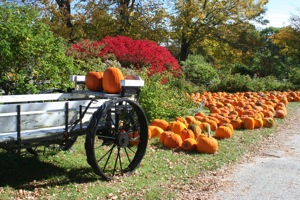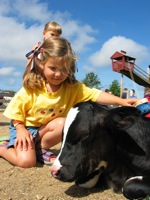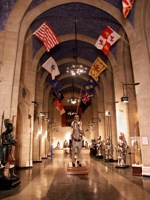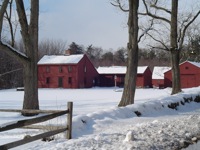
Although as far as is known Johnny Appleseed didn’t plant any of his legendary apple trees in his native Massachusetts, the rolling north central area of the state where he was born in 1774 is known as the Johnny Appleseed Trail, and the well-stocked Johnny Appleseed Visitor Center in Lancaster is a good jumping-off point for visiting the area.
“Johnny Appleseed was born here; his real name was John Chapman,” said Diane Burnette, director of the visitor center. “He was a real person.”
Although Appleseed nee Chapman may not have played a role, the region bordering State Route 2 as it runs parallel to New Hampshire is dotted with apple and other fruit orchards.
“Orchards are our strong suit,” said Burnette. “You can find 50 different types of apples in our area.”
The Johnny Appleseed Trail is one of five distinct regions of the Central Massachusetts tourism region that encompasses more than 60 cities and towns in the heart of the state.
Often overshadowed by Boston and Cape Cod to the east and the Berkshires to the west, the diverse and interesting region features knights in shining armor, brightly painted chalk statues of Santa Claus and the Easter Bunny, a failed Utopian community, elaborate 18th-century clocks, 5,000 years of art, an 1830s New England village, rolling hills, a mountain, charming small towns and eclectic shopping opportunities in addition to the u-pick fruit orchards.
“We have five regions, and all are really different,” said Lauren Carroccia, marketing and sales coordinator for the Central Massachusetts Convention and Visitors Bureau. “Each has its own feel.”
Worcester, Massachusetts’ second largest city and an economic and cultural hub of the region, “has all the characteristics of a big city but within a smaller area,” said Carroccia.
The Blackstone Valley along the Blackstone River is a historic area of mill villages that played a critical role in the Industrial Revolution, Corridor Nine is a shopping destination along Route 9, and the Johnny Appleseed Trail has its orchards and farms.
“Sturbridge is the quintessential New England area,” said Carroccia. “It has Old Sturbridge Village and lots of inns and bed-and-breakfasts for people who want to get that New England feel when they visit.”
Carroccia noted the Central Massachusetts area is also conveniently located. “We are ideally located within an hour from Boston, the Berkshires and many other New England states,” she said. “We are in the heart of New England.”
Worcester
You might not expect to find a mail-clad Crusader on horseback or a full-set of Renaissance body armor in the middle of Massachusetts. However, that’s just what you will find, and plenty more, at the Higgins Armory Museum in Worcester.
 “We have armor ranging from the ancient Greeks to the Renaissance, nothing more modern than that,” said Libbie Armstrong, the museum’s public relations director.
“We have armor ranging from the ancient Greeks to the Renaissance, nothing more modern than that,” said Libbie Armstrong, the museum’s public relations director.
“There is the typical knight in shining armor. We are the only museum with a solely dedicated collection of arms and armor in its original house. We are just arms and armor. Our collection was put here by its founder.”
Worcester industrialist John Woodman Higgins built the four-story art deco, steel-and-glass building in 1931 to house his large collection of arms and armor from Europe, Japan and ancient Greece and Rome.
“At the time, it was very state of the art,” said Armstrong. “It is modern on the outside, but the insides look like a castle. It is very Old World on the inside; it has as wonderful feeling like being taken back in time.”
The collection features nearly 50 suits of armor, 1,000 weapons, 500 swords and daggers, 100 firearms, a tapestry, stained glass, paintings and wood carvings. Its non-Western collection includes 1,000 African, Islamic, Indian and Japanese body defenses and arms.
Armstrong said groups can arrange a presentation in the auditorium on topics such as a Gothic knight, a Roman legionary, a 14th-century knight or pike and shot. They also can get a guided tour of the museum.
The armor ranges from utilitarian pieces from the 1600s to the ornate decorations of late Renaissance armor that are almost pieces of art.
Art of a different kind is at the Worcester Art Museum, whose 35,000-piece collection of paintings, sculpture, decorative arts, photography, prints, drawings and new media spans 5,000 years.
There are paintings by Cassatt, Gauguin, Goya, Monet, Sargent and Whistler; floor mosaics from the ancient city of Antioch; and cutting-edge contemporary art.
With only a fraction of its large collection on display at any one time, the museum organizes temporary exhibitions in contemporary, Asian and prints, drawing and photographs to allow visitors to see more of the collection.
The museum was opened to the public in 1898.
Worcester is the region’s center for performing arts, with the 2,300-seat, state-of-the-art Hanover Theatre, which hosts Broadway shows and concerts, and historic Mechanics Hall, the 153-year-old ornate concert hall that was extensively renovated and restored early last decade.
Johnny Appleseed Trail
Burnette said the Johnny Appleseed Trail’s diversity extends from “arts to farms,” with the Tower Hill Botanic Garden, the Fruitlands Museum and the Fitchburg Art Museum with its 14 galleries of American and European paintings and Greek, Roman, Asian and pre-Columbian antiquities in addition to its many orchards.
 Fruitlands Museum, a National Historic Landmark, is the site of Bronson Alcott’s brief attempt at a transcendentalist commune in 1843. In addition to buildings used by Alcott, the 200-acre site includes a 1794 Shaker Office with exhibits about nearby 19th-century Shaker communities, a gallery with Native American materials and a Fine Arts Gallery with a large collection of Hudson River landscapes and 19th-century vernacular portraits.
Fruitlands Museum, a National Historic Landmark, is the site of Bronson Alcott’s brief attempt at a transcendentalist commune in 1843. In addition to buildings used by Alcott, the 200-acre site includes a 1794 Shaker Office with exhibits about nearby 19th-century Shaker communities, a gallery with Native American materials and a Fine Arts Gallery with a large collection of Hudson River landscapes and 19th-century vernacular portraits.
The area’s orchard also feature raspberries, strawberries, blueberries, and peaches. “Most of the orchards have their own farm stands and sell their own products,” said Burnette.
In addition to apples, the Davis Farmland focuses on endangered farm animals, including Scottish highland cattle the business was started around in the mid-1990s after a fire destroyed the family’s dairy barn. Other animals include Nigerian dwarf goats, St. Croix and Tunis sheep, a miniature Sicilian donkey and a water buffalo.
From August to October the farm, now in its seventh generation, has a large three-dimensional corn maze, the Mega Maze.
Two generations of the Keown family work at Keown Orchards in Worcester County, which has been in the family since 1924. The 175-acre farm, open from mid-July through Christmas Eve, has a wide variety of apples, including many antique varieties, along with pears, peaches and vegetables.
“And if you are adventurous, we have Zoar Outdoor, which has white-water rafting and zip lining,” said Burnette.
Blackstone Valley
A tour of Vaillancourt Folk Art Shop in the Blackstone Valley won’t produce the thrills of zip lining, but it will provide an informative and interesting stop.
“We are a studio, retail gallery and museum,” said Bette Keene, who works with groups at the family-owned shop in Sutton, Mass. “All three are on one floor in an 1820s stone mill.
 “We create chalkware figurines poured in antique chocolate molds. Chalkware is a plaster-like substance that was an art form in the late 1800s and was sold by itinerate salesmen.
“We create chalkware figurines poured in antique chocolate molds. Chalkware is a plaster-like substance that was an art form in the late 1800s and was sold by itinerate salesmen.
“Ours are slightly different in that we use the chocolate molds, which have fantastic detail,” said Keene.
The figurines, which are hand-painted in artist oils, have become collectibles. Although there are a great many varieties, the majority are Christmas oriented with Father Christmas, Santa Claus and snowmen. Several types of detailed rabbits are also popular, especially in the spring around Easter.
Glass ornaments designed by owner Judi Vaillancourt to go with the figurines are hand-blown in Poland and sold in the store.
Keene said groups can get tours of the factory. “They see the start-to-finish process of making the figurines,” she said. “The see the pouring room, watch the artists paint and see the finishing area. They then have a tour through the museum, which has all of Judi’s originals and a lot of the molds in her collection. We have hundreds of styles.”
And, of course, there is plenty of time left for shopping.
Speaking of time, the Willard House and Clock Museum in Grafton includes the 1718 house of Joseph Willard, the patriarch of one of America’s leading 19th-century clock-making families.
The museum has the largest collection of Willard clocks, which are displayed in period room settings in the Willard house, the 1766 factory and three modern galleries.
In addition to the more than 90 Willard clocks, the museum has period furniture, antique Oriental rugs, 19th-century women’s costumes, Victorian dolls, Indian artifacts and original documents signed by Thomas Jefferson and James Madison.
Researching Your Trip:
Central Massachusetts
Convention and Visitors Bureau
www.centralmass.org
(866) 755-7439
Massachusetts Office of Travel and Tourism
www.massvacation.com
dagny.ashley@state.ma.us
(617) 973-8511
(800) 227-6277










